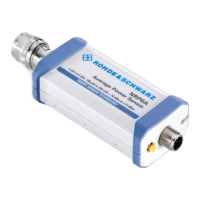R&S NRP Annex: Remote Control - Commands
1144.1400.12 Annex - I.13 E-2
If triggering needs to occur in response to a rising signal edge, the trigger system has to be configured
with TRIG:SOUR INT and TRIG:SLOP POS:
*RST
TRIG:SOUR INT (triggering in response to a signal edge)
TRIG:SLOP POS (triggering in response to a rising signal edge)
INIT
FETCh?
Note: The settings of commands TRIG:SOUR and TRIG:SLOP are ignored in the
BurstAv mode. In this mode the beginning and the end of the power pulse
are automatically recognized. For this reason, the instrument always
triggers INTernal even if TRIG:SOUR has a different setting.
If a trigger signal is to be routed to the instrument rear panel via the external trigger connector, the
trigger source has to be configured with TRIG:SOUR EXT.
*RST
TRIG:SOUR EXT (triggering in response to the edge of an external signal)
TRIG:SLOP POS (triggering in response to a rising signal edge)
INIT
FETCh?
TRIG:SOUR BUS can be set if measurements are to be started with *TRG or GET. This procedure is
provided by standard IEEE 488.2, which stipulates that *TRG or GET can also be used to perform
complete measurements. This includes the generation of an answer, the measurement result. In the
R&S NRP, *TRG does not have this meaning: *TRG only executes a trigger event and thus only causes
the status transitions from WAIT_FOR_TRG to MEASURING. *TRG delivers no measurement result
and has no effect if TRIG:SOUR is not set to BUS or if the instrument is not in the state
WAIT_FOR_TRG. The latter situation applies, for example, if the R&S NRP is IDLE, i.e. INIT:CONT
ON is not set nor was INIT executed.
Delay, holdoff and exclude
Normally, the measurement immediately starts after the trigger event has been executed. This may not
be desirable if the measurement is to be started before or after the trigger point. The start of the
measurement with reference to the trigger point can be offset using the TRIG:DEL command. A
negative sign means that the measurement begins before the trigger point. This is possible because the
sensors store sampling values for a while and can use past values when the measurement is started.
The command is also used when overshoots are to be ignored at the beginning of a power pulse.

